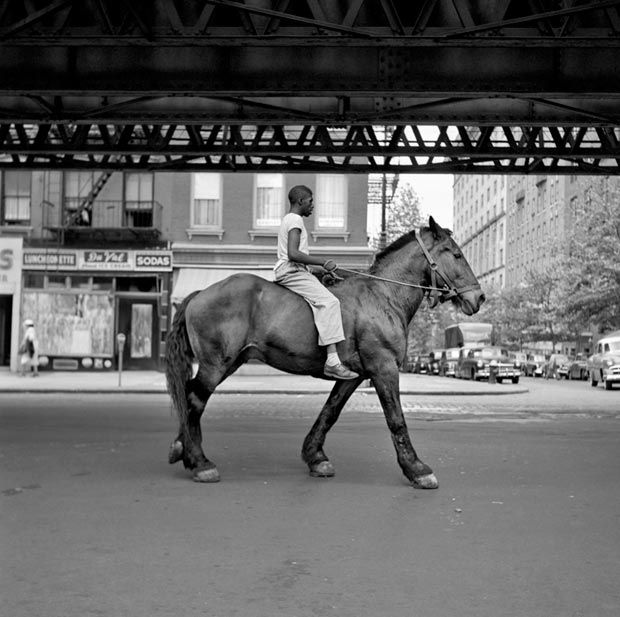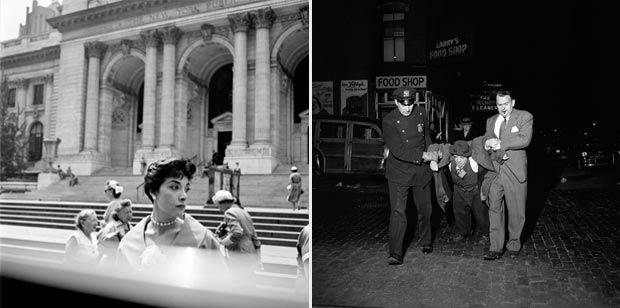
African-American Man on Horse, NYC, still from John Maloof and Charlie Siskel’s Finding Vivian Maier (photos by Vivian Maier | Courtesy of the Maloof Collection)

Left, New York Public Library, New York, c. 1952, still from John Maloof and Charlie Siskel’s Finding Vivian Maier. Right, Man being dragged by cops at night still from John Maloof and Charlie Siskel’s Finding Vivian Maier.
Vivian Maier was a self-taught street photographer who worked as a nanny for decades and died in obscurity. She began shooting photographs in New York City in the 1950s before moving to Chicago, where she lived nearly all of her life. By the 1990s, she had amassed an unparalleled – and largely unknown – body of photographic work.
Her story came to light when John Maloof purchased a box of photographs at an auction house while hunting for 1960s photos of Chicago. While he and his co-author did not find what they needed for their book project, the purchase led Maloof gradually to unearth an archive of 100,000 to 150,000 negatives, more than 3,000 prints, hundreds of rolls of film, home movies, audiotape interviews, personal papers and other items. When Maloof shared an initial blog containing about 100 of Maier’s photos, he embarked upon nearly a decade of non-stop archiving, preserving and promotion of Maier’s work. Through contact with one of the families for whom Maier worked, he acquired two packed storage lockers filled with her personal belongings and began to construct a timeline of her life.
Finding Vivian Maier, a critically acclaimed documentary by Maloof and Charlie Siskel, reveals the life and work of the prolific and accomplished street photographer. The film will be shown on Saturday, June 4 at Upstate Films, 132 Tinker Street in Woodstock at 4 p.m. The screening will be followed by a reception and exhibition at the Center for Photography in Woodstock (CPW) at 59 Tinker Street. The opening of the art show, featuring 14 of Maier’s photographs, will include a question-and-answer session with gallerist Howard Greenberg and Maloof, who rarely makes public appearances due to his busy schedule. Both events are part of the Woodstock Artists Association and Museum’s “Dialogues Series.”
The decision to mount a show of Maier’s work at the Center for Photography in Woodstock brings Greenberg back “home;” he was one of the founders of CPW. “Howard has such a wide reach, and a lot of connections,” says Maloof. “I focus mainly on processing, archiving and working with the material, and he handles the gallery promotion of her work. We’re a really good team.”
Discovering Maier’s photographs, negatives and the rest of her possessions altered the course of Maloof’s life, but he is not alone in his affinity for Maier. “A lot of people are obsessed by her. As soon as you see how good her work is, and learn a little bit about her as a person…she’s fascinating, mysterious. You think you can figure her out – and there are so many clues, teasers – but there’s never a full picture of her,” says Maloof. “She kept her personality and her emotions to herself, and that makes the clues and bits of her life very provocative and interesting.”
He fell deeply into research about her life and got immersed, even approached burnout, and included genealogical investigations alongside countless hours of interviewing people who knew Maier. “I’m not going to continue with this forever, but I am in charge of the archives, so I will be working on this for a long time. I had to stop for a while because I have some personal art projects to do.”
Over the course of his life, Maloof’s passions have borne fruit in stints as president of the local historical society on Chicago’s Northwest Side, co-authoring a history book (Portage Park), a few years of real estate work and side businesses in restoration hardware and antique restoration. But his primary work has always been art. “I went to Columbia College Chicago, and am a photographer, painter, filmmaker and musician. I’ve been playing guitar since 1995 and am working on a recording in my own studio now,” he says.
As a painter, Maloof creates pieces that employ design elements, bright colors and simple handpainted shapes using reverse acrylic paint on Plexiglas. Vivian Maier “has become such a famous figure – people are celebrating her all over the planet now – that her work tends to overshadow all the other things I do, but it doesn’t bother me. I wasn’t really a photographer before I found her archive. I got inspired… I have a camera around my neck right now, and I don’t ever leave my house now without it.”
In addition to the materials already documented, Maloof is currently processing 500 to 600 rolls of 35mm film footage taken by Maier. Greenberg says, “I’ve started to get very, very interested in those rolls of film. Maier has taken such a high percentage of good photos, I’m really curious about what’s on them.”
Greenberg’s New York City gallery now owns about 100 Maier photographs. Despite all his years as a gallery-owner and photographer, Greenberg says, “I’m completely blown away by Vivian Maier’s story, and I’ve never experienced anything like this. I’ve been a photographer, and I have never, ever run across a person who made so many photographs, and who was obsessed by photography for so many years, with apparently no interest in showing her photos. The profound and widespread interest in her work is quite a phenomenon, and it’s ongoing.”
Maloof says that many people have the misconception that Maier was shy, that she didn’t talk to anybody and that she was a hermit, reclusive. “But she was very in-your-face [as a photographer and as a person], very opinionated and not shy at all. She was the opposite, really, and so bold. That’s why people remember her.”
Today, in Maier’s honor, Maloof, Siskel and Greenberg have established an endowed Vivian Maier Scholarship Fund at the School of the Art Institute of Chicago, one of America’s leading art and design schools and a place that was important to Maier. Each year, a female art student receives financial assistance to allow her pursuit of art with some of the economic burdens relieved: a fitting tribute to a talented photographer who supported herself and her art while working as a nanny.
“People who haven’t heard of Vivian will be intrigued, and the amount of work that she did is riveting. I’m still unraveling her life, and I don’t have all the answers. If I could ask her something, I’d want to know if she’s okay with my handling and showing her work,” says Maloof. “My favorite item in the archives is a letter that she sent to a lab in France. It documents her intentions to print her photos and to make multiple copies to sell. She did want to show her work, at least at one point.”
Greenberg adds, “I’ve never seen so much demand for photographic work. We’re circulating about three different collections of Vivian’s work around the world right now.” And one such collection will be in Woodstock this weekend.
Finding Vivian Maier screening, Saturday, June 4, 4 p.m., 10/$7, Upstate Films, 132 Tinker Street, Woodstock; Vivian Maier exhibition opening reception/Q&A with Howard Greenberg & John Maloof, 7 p.m., Center for Photography in Woodstock; (845) 679-2940, www.woodstockart.org.
